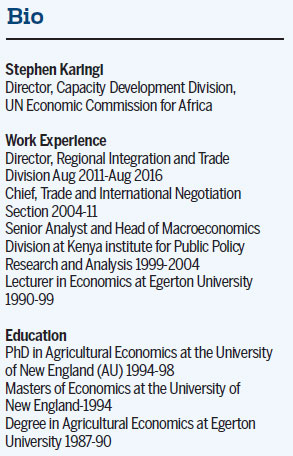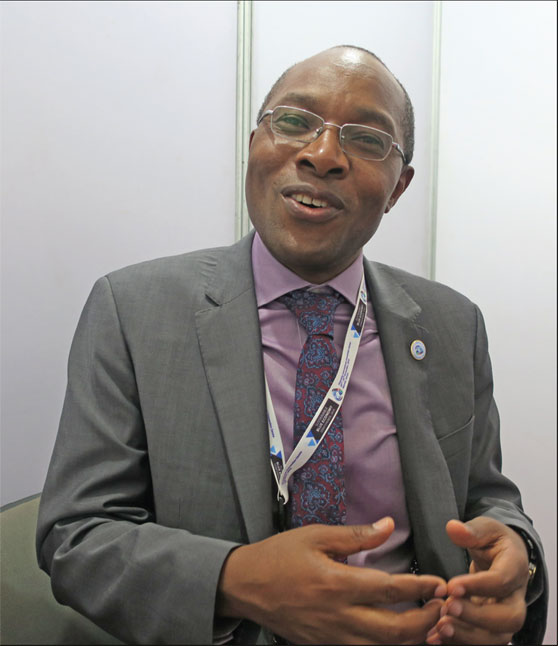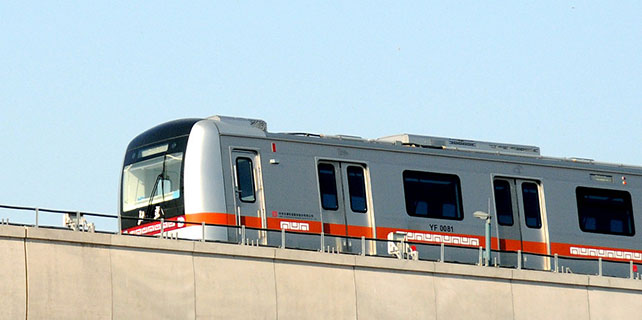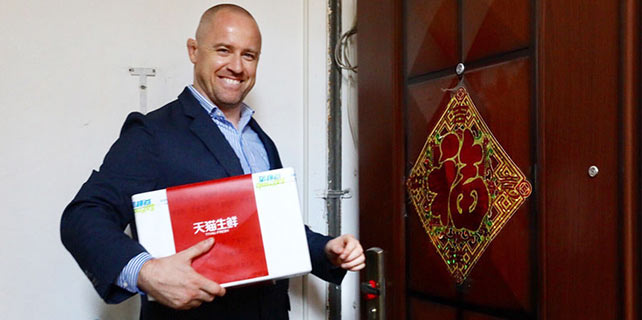Africa's single market closer to reality
BRI is fast-tracking free trade in Africa, but debt concerns loom on the continent
China's participation in Africa's growing infrastructure sector is fast-tracking the integration process and pushing closer to creating a $3 trillion (2.6 trillion euros; £2.4 trillion) single market, says Stephen Karingi, director of the capacity development division at the UN Economic Commission for Africa. Based in Addis Ababa, Ethiopia, his docket also includes regional integration, placing him at the heart of assisting countries to develop the right set of policies that support open markets to successfully implement Africa's new brainchild, the Continental Free Trade Area.
The CFTA was signed in March this year by 44 countries that pledged to boost intra-African trade by removing trade barriers, increasing investments in industrialization and infrastructure expansion and consequently creating jobs for the world's fastest growing labor force. At present, 12 countries have ratified the agreement and 22 countries are needed for it to take effect.
|
Stephen Karingi, director of the capacity development division at the UN Economic Commission for Africa, says BRI projects are pushing Africa closer to realizing the single market agreement. Lucie Morangi / China Daily |
"Fundamentally, for the agreement to be realized, the continent requires the right physical infrastructure. We need modern cross-border transport, energy and information and telecommunication connectivity. This is integral to the success of the trade deal," the former economics professor says.
Karingi says the Belt and Road Initiative, launched five years ago by President Xi Jinping, has fueled the infrastructure boom across the continent, creating an enabling environment to facilitate cross-border trade. But despite galvanizing Africa's investment environment, the continent has also seen an increase in sovereign debt levels, bringing with it a wave a strong criticism.
Karingi, however, believes that the ongoing debate, on whether the debt uptake is sustainable misses the point. "The issue should be on whether it is financing transformative projects," he says.
Notably, he adds, the BRI supports projects that are cross-border and have a wider scope. He notes that the Beijing Summit of the Forum on China-Africa Cooperation strongly maintained China's commitment to taking an inclusive approach in BRI implementation.
"This underscored the inclusiveness of the initiative in not only targeting the East African region but opening it up to the whole continent to participate in it."
Most importantly, China concurred with the approach of co-financing transborder infrastructure projects. The benefits would reach more than one country, have an immediate impact on trade and diversify the risks to investments, Karingi says. "This means that more than one country takes up repayment of the loan."
China is already forging ahead. The $3.8 billion modern railway in Kenya, which was largely financed and built by China, is expected to stretch from the port of Mombasa to Uganda, Rwanda and finally the Democratic Republic of the Congo. "Hence, it makes it possible to have a land bridge connecting the Indian and Atlantic Oceans. Terminating the railway in East Africa would deny the continent optimal benefits accrued from integration," he says. He noted that the Djibouti-Ethiopia railway is another successful project under BRI.
Africa needs such projects, Karingi says. Interconnectivity has been poor because of missing links as projects only get implemented in one country. Many lofty pan-African ideas have come to naught due to lack of cross-border infrastructure. These programs include the Cape-to-Cairo project that planned to link the south and north by rail, the three UN Transport and Communications Decades in Africa and the Trans-African Highway networks.
The BRI, in itself, increases access to financing, Karingi says. This includes programs such as the Silk Fund, the China Africa Development Fund and the $60 billion financial package pledged by President Xi during the FOCAC summit in Beijing.

But with the increased uptake of loans comes with it questions on whether Africa's debt is sustainable.
"There is heavy financing on the books of the African debt portfolio," Karingi says.
He adds, however: "First, to be clear, the debt is not dominated by loans from China, and second, I don't think African leaders are making blind decisions. Transformative infrastructure is in place. Hundreds of kilometers of modern rail has been developed in the recent past, together with thousands of kilometers of new roads and an injection of additional energy into national grids. I know of new bridges connecting borders across rivers that never existed before. Lowered production costs have resulted in new industries. I think it is rather too soon to be raising queries on whether the projects are giving returns. Invariably, there is a lag period before returns on investments are realized. This is sometimes estimated at three years assuming prevailing conditions are right and the project is complete. This, however, should not encourage imprudent accumulation and misuse of loans."
Karingi notes that no infrastructure development can take place without finances.
"Debt in itself is not bad. China's debt-to-GDP ratio is high, but it was effectively used to finance industrialization and energy to make it the global factory. Planning and proper coordination between countries is therefore our best bet for realizing the CFTA."
He adds: "It can be achieved at breakneck speed or gradually. It is a question of balance and prioritization. First, establish the job creators, and with time the accumulated growth will repay the loans. For those who are cautious and risk averse, the pace will be slower."
This brings into play the recent surge in construction of special economic zones to attract foreign investments, a model that spurred rapid economic growth in China. The zones fundamentally support intra-African trade for finished products. Despite creating an ecosystem around mega infrastructure projects, recent global headwinds makes them susceptible to economic shocks."
"This strategy does not take into account international or domestic shocks that immediately erode gains and undermine the ability to repay loans," Karingi says. "The risk analysis for these investments should be done more robustly. No one expected the ongoing trade tensions between China and the US, and because we are part of the global value chain, there are some negative impacts on us too."
Ethiopia and Kenya have been pursuing this model around the existing railways. Karingi proposes the need for innovative policies and regulations to improve investment environments and encourage not only foreign direct investment but also a robust private sector.
"The SEZs are ideal breeding ground for the private sector who are growth nodes for economic transformation. With good infrastructure, small and medium-sized entrepreneurs will be the biggest winners. Investments become easy, especially with infrastructure in place."
He said that since the signing of the CFTA, the momentum is still high and it is expected to come into force by the middle of next year. Meanwhile, the continent is expanding its infrastructure capacity in preparation for the expected surge in trade.
"Once it comes into force, intra-African trade is expected to jump from 17 percent to beyond 22 percent within a very short time and hence increase our global trade participation. With the increased volume of trade, our current port and transport capacity will be overwhelmed and thus the need for bigger ports and better connectivity. This move by Africa is therefore aligned to BRI projects," Karingi says.
The second round of AfCFTA negotiations is expected to commence early next year where issues such as competition policy to create a level playing field, intellectual property, recognizing local production of goods and services and investment protocols that make it possible to invest in one country while reaching multiple countries will be ironed out.
Meanwhile, Karingi says, negotiations on a repayment system are at an advanced stage.
"We are looking at developing a system that recognizes an entrepreneur's digital identity to facilitate cross-border trade."
By using big data technology and gains already made in e-commerce, the system will further blur borders and reduce the need for the use of a common currency, he says.
"People will be able to trade using their own currencies."
lucymorangi@chinadaily.com.cn
(China Daily Africa Weekly 12/14/2018 page27)

















